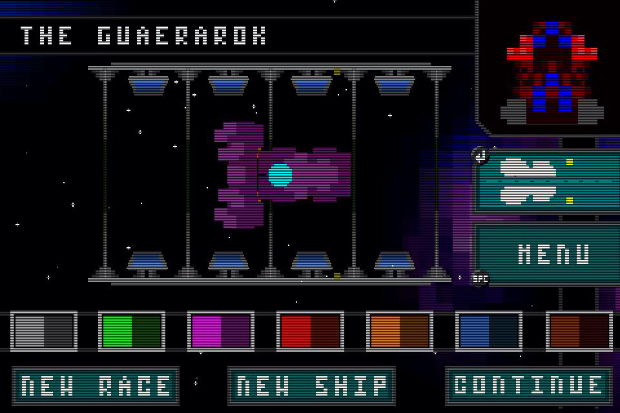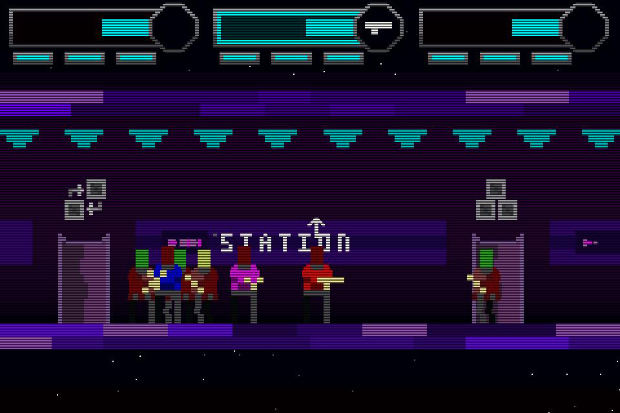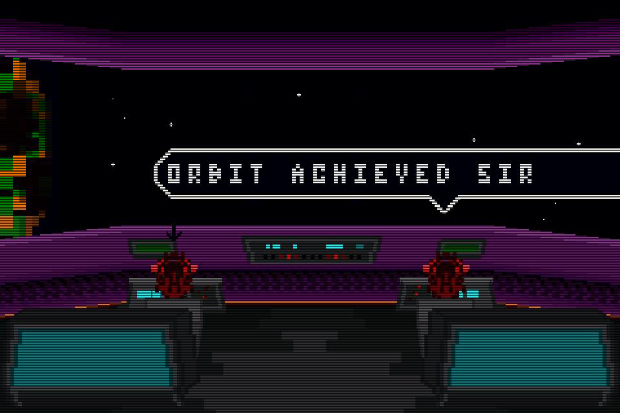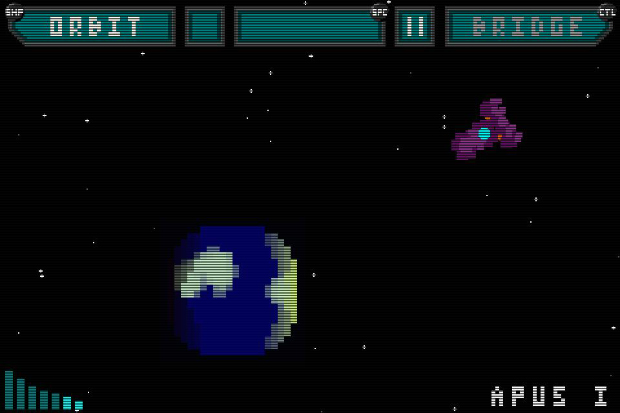Premature Evaluation: Tiny Trek
Highly illogical
Each week Marsh Davies boldly goes where only a small cadre of erratic and often unintelligible Steam reviewers have gone before - Early Access - and comes back with any stories he can find. This week he sucks in his beer-gut, stretches on his gold spandex top and prepares to beam down into Tiny Trek, a procedurally generated lo-fi space-faring sim.
Back when I lived alone in a graveyard, in a forest, in isolation, and had a lot of time on my hands, I would occasionally entertain myself by trying to impersonate Jean-Luc Picard’s replicator request for “Early Grey! Hot! Black!”, sometimes for hours on end. How we used to laugh, my imaginary friends and I, as I’d command Ensign Woodlouse to take us to warp, or open diplomatic communications with the mould patch in my bathroom that had begun to resemble a screaming face. I can’t have that sort of fun these days because my housemate is liable to walk in and tell me to put my trousers back on. But, suffice to say, I am WELL UP for a digital Star Trek fantasy that offers just the right amount of engagement for my labrador-like attention span.
Unfortunately, Tiny Trek is not it. Not yet.
Some descriptions of what Tiny Trek currently is: really cool in theory; designed with a complete disregard for comprehension; non-functional in a dozen or more ways. It’s a procedurally generated space adventure that hopes to map and miniaturise all the principle Trekky interactions - scanning, diplomacy, away missions, space battles and so forth. The dev's site talks a great game: a procedural mission matrix that builds episodes of adventure in which your decisions matter and across which interspecies relations persist. It allows for customisation, too, from the shape and colour of your ship, to the geology of your home planet. Unfortunately, you might easily think the controls had been procedurally generated along with the missions, as you stab at the keyboard trying to work out which button is assigned to, well, anything. Some buttons allow activation by mouse. Some don’t. Some do intermittently. Some buttons take you to a screen of empty menus and a weblink and then restart the game, erasing all progress. This ain’t the holodeck.
Early Access means accepting some degree of wonk, of course, and so perhaps I need to employ some of that Federation noblesse and rise above the game’s operational problems, to see it for what it wants to be. And so…
These are the voyages of the starship Guaerarok, at least up until the point where it gets deleted and I start again. I don’t get to choose the name, but I do get to choose the shape using a neat little voxel editor. It’s going to be dick-shaped. Of course it’s going to be dick-shaped. My home planet is the first of five orbiting a small red sun, and I select it because it imbues my people with a good deal of wisdom and logic, albeit at the expense of empathy and along with a good deal of aggression. Which I suppose would make me a Romulan if my species weren’t also bright red with three blue eyes and grey mandibles.
We are still bipedal at least, as I discover on the next screen, which takes me to a corridor of a space station. Within it are a number of green headed folk, and what I presume to be my away team. I spend a long time on this screen trying to work out how to control any of them or what I’m meant to be doing, if anything. Tapping one of the icons at the top of the screen, I end up shooting all of the green-headed aliens on board. Shift, I gather, makes members of my team jump. Spacebar switches between them. I am, nonetheless, stuck in a corridor. At points, members of my team relocate to a foot off the ground and become immobile. Eventually I navigate an active unit to a doorway and, employing the sort of cool-headed decision-making that earmarked me for command, I slap the keyboard with the palm of my hand until something happens.
Something happens! I’m in space! My tumescent purple spacewang is currently latched onto a rotating spacestation. I have the options to Break, Embark or Bridge, and, figuring I should inspect the helm of my ship before launching into the abyssal dark of space, I choose the last. What greets me is gratifyingly Trek: a viewscreen looking out onto space, the horizon line of a planet visible on the left (never mind that we were orbiting a spacestation and not a planet) and two bulbous-headed crew awaiting my instruction. Clicking on either lights up a different selection of options on panels at the base of the screen, though these are only intermittently clickable it seems. One eventually concedes, and I am able to scan the planet, finding little to no interesting information. It’s 88% biological and 95% mineral. Is that good? What can I do with that? The game does not say.
I also manage to coax it into showing me the transporter interface. I fail to identify whether bits of the design are just for show or simply broken, but I do manage to drop a cursor on a grid - presumably indicating the coordinates to which my party will transport. It’s hard to say whether this action has any meaning, however. Then the transporter room itself: I can select the make-up of my team. Redshirts, science officers, medics. Going by my experiments on the station, however, only the redshirt can do anything, and that’s to shoot. I am a warlike species after all. Activating the transporter allows for a trivial minigame in which you readjust sliders to a shifting sweetspot, allowing the machine to charge. And then my crew are gone in a puff of sparkles.
Down on the surface I quickly establish there is nothing to do except walk left or right and shoot inert green-headed people for no reason, who then sit down. And I can only shoot to the right, even when facing left. The larger problem is that I have no clue how to get back. Eventually I discover that hitting Enter prompts the query: “Return to the ship?” but I can’t click the yes button. The fault is mine, however: at the top left of the button, in letters so small as to be barely readable, and further obscured by the scan-line effect, is the word “SHF”. For Shift, of course. Pressing Shift for “Yes” and and Ctrl for “No” is not an especially familiar interactive shorthand, but then I suppose I am an alien.
Back on board the ship, I manage to break away from the spacestation, now controlling my ship from an external view, flying in a 2D plane using the cursor keys. No sooner have I disembarked, however, than I am launched into a combat simulation. Desperately clicking on bits of the screen to make something happen, I somehow switch into combat mode and then launch a volume of missiles and lasers at my enemy, blowing away voxel chunks from its hull. This continues for what seems like a very long time, until I’ve etched away all of my opponent’s shell and reduced it to an apparently indestructible core. Maybe this is meant to be an impossible scenario to win, like the Kobayashi Maru, only instead of blowing up you just keep clicking until you reach the end of your natural life. I somehow manage to navigate my way back to the view from the bridge, and, perplexingly, this restarts the entire simulation. I poke at another anonymous symbol while on the bridge, and I'm transported to a page with a big black box in the centre and a link to tinytrekvoyages.com. Clicking anywhere then takes me back to the game’s main menu to start all over again.
Some several, equally frustrating, truncated space adventures later and I encounter something new: as I scan a particular system I pick up a distress beacon. I answer it eagerly and find myself amid swirling asteroids. Another ship slowly drifts, visibly damaged, and then immediately ploughs into an asteroid and explodes. I pootle about for a while, but there’s nothing else here as far as I can see. My one chance at heroism turned to stardust. Oddly, when I return to the bridge the viewscreen shows I am still in communication with the alien that made the distress call. I have no way of knowing what any of the symbols I am presented with mean, alas, and one of them sends me to the game’s screen of death, never to return.
Underneath the terrible interface choices and suicidal menu options, there are flashes of the game I want Tiny Trek to be. A little bit of Redshirt, a little bit of FTL, a little bit of Heat Signature, a little bit of Artemis - all mixed together and boiled down into something light and quick and jolly. Its simulation of Trekky trappings doesn’t have to be sophisticated or intricate, but it does have to mean something. Interactions and choices need to link up in some more visible way. It needs to explain itself better, or indeed at all. And, of course, the game has to function. Such is the promise of procedurally generated spacefun that I truly hope Tiny Trek makes it so, but unless the devs work at warp speed, I fear it’s going to be a long journey.
In the meantime, you’ll find me in my quarters. Knock before you enter, Number One. I may have to put some trousers on.
Tiny Trek is available from Steam for £4. I played version 1.21 on 26/01/2015.






